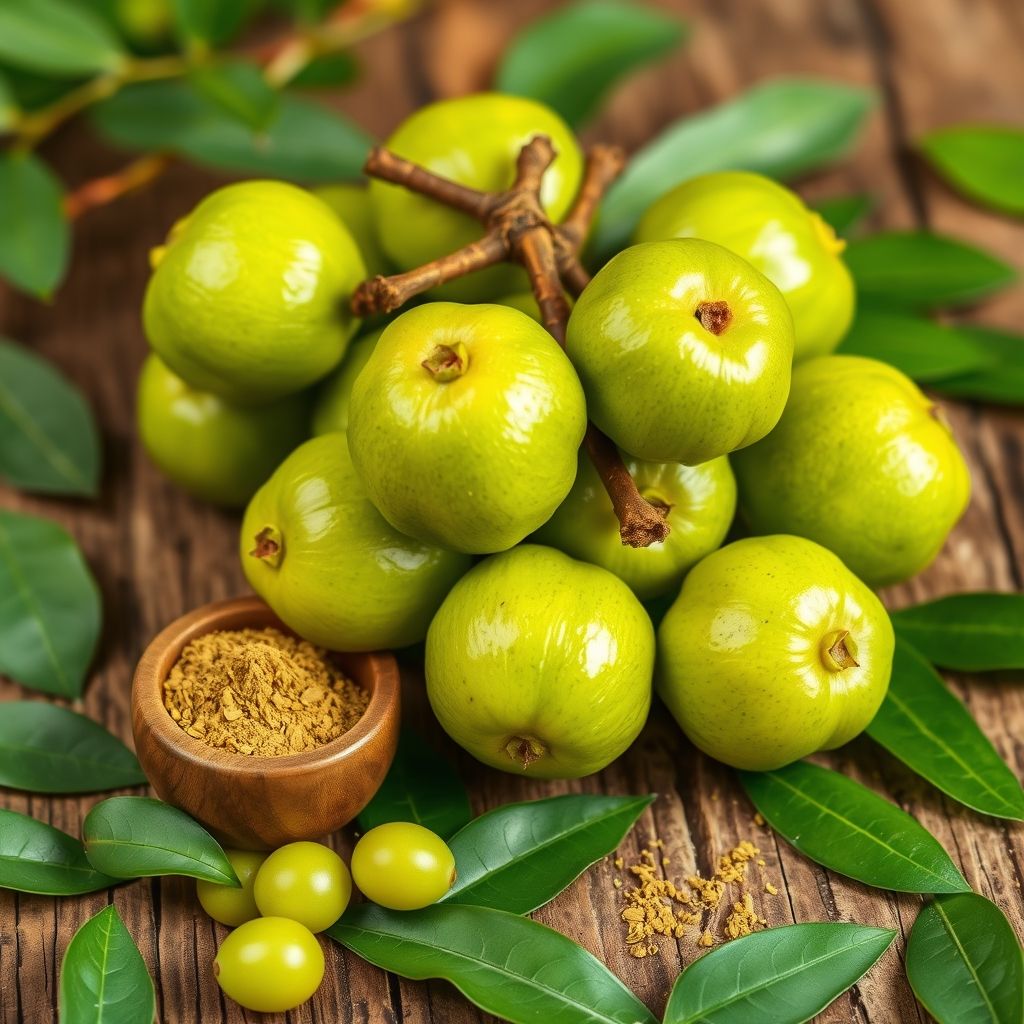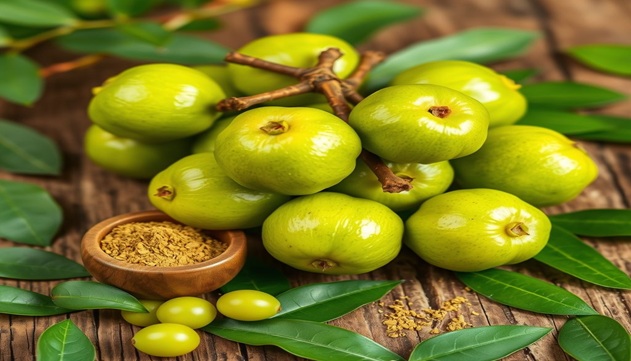Table of Contents
- What is Amla Churna?
- Method of Preparation
- Suitable Age Groups for Consumption
- Recommended Dosages
- Benefits of Amla Churna
- Who Should Avoid Amla Churna?
- Other Medicines Using Amla Churna
- Comparison with Ashwagandha Churna and Triphala Churna
What is Amla Churna? | Benefits of amla churna
The benefits of amla churna are accessible to a wide range of age groups, from children to the elderly, with appropriate dosage adjustments.Amla churna, derived from the Indian gooseberry (Phyllanthus emblica), is a finely ground powder celebrated in Ayurveda for its potent health benefits. Known as “Amalaki” in Sanskrit, amla is revered for its rich vitamin C content and antioxidant properties. The benefits of amla churna extend across various aspects of health, making it a staple in traditional Indian medicine. This herbal powder is valued for its ability to support immunity, digestion, and overall vitality, positioning it as a versatile remedy in holistic wellness practices.
Method of Preparation | Benefits of amla churna
Preparing amla churna is a meticulous process that ensures the retention of its therapeutic qualities. Fresh, ripe amla fruits are harvested, thoroughly washed, and deseeded. The fruit pulp is then dried under controlled conditions, typically in the shade, to preserve its nutrients. Once fully dried, the pulp is ground into a fine powder using traditional stone grinders or modern milling equipment. The resulting amla churna is sifted to achieve a smooth texture, ensuring the benefits of amla churna are maximized for consumption. Homemade versions follow a similar process, though commercial preparations may include quality checks to maintain consistency and purity.
Suitable Age Groups for Consumption
Children above the age of five can safely consume amla churna in small quantities, often mixed with honey or water to enhance palatability. Adults, including pregnant and breastfeeding women, can incorporate it into their diets after consulting a healthcare provider. Elderly individuals also benefit from amla churna, particularly for its role in supporting immunity and joint health. However, infants and toddlers under five should avoid it due to their sensitive digestive systems.
Recommended Dosages
The dosage of amla churna varies based on age, health condition, and purpose of use. For adults, a typical dose ranges from 3 to 6 grams (approximately 1-2 teaspoons) daily, often taken with warm water, milk, or honey to enhance absorption and amplify the benefits of amla churna. Children aged 5-12 years may take 1-2 grams daily, while teenagers can follow adult dosages under supervision. For specific conditions like acidity or hair health, dosages may be adjusted by an Ayurvedic practitioner. Consuming amla churna in moderation is key to avoiding potential side effects like stomach upset.
Benefits of Amla Churna
The benefits of amla churna are extensive, making it a powerhouse in natural health remedies. Below are some of its key advantages:
- Boosts Immunity: Amla churna is rich in vitamin C and antioxidants, which strengthen the immune system, helping the body fight infections and seasonal illnesses. Regular consumption enhances the benefits of amla churna in building resilience against colds and flu.
- Supports Digestive Health: The fiber content in amla churna aids digestion, alleviates constipation, and promotes a healthy gut microbiome. Its mild laxative properties make the benefits of amla churna particularly effective for those with sluggish digestion.
- Promotes Hair and Skin Health: The antioxidants and vitamins in amla churna nourish hair follicles, reduce hair fall, and delay premature graying. For skin, the benefits of amla churna include improved complexion, reduced acne, and protection against oxidative stress, contributing to a youthful glow.
- Enhances Heart Health: Amla churna helps regulate cholesterol levels, reduces triglycerides, and supports cardiovascular health. The benefits of amla churna in maintaining healthy blood pressure make it a heart-friendly supplement.
- Aids in Blood Sugar Regulation: The benefits of amla churna extend to diabetes management, as its bioactive compounds improve insulin sensitivity and help stabilize blood sugar levels, making it a valuable addition for diabetic individuals.
- Improves Liver Function: Amla churna detoxifies the liver, promoting its ability to process toxins and maintain metabolic balance. The hepatoprotective benefits of amla churna are well-documented in Ayurvedic texts.
- Anti-Aging Properties: The antioxidants in amla churna combat free radicals, slowing down the aging process and preserving cellular health. This enhances the long-term benefits of amla churna for vitality and longevity.
- Supports Eye Health: Rich in vitamin A and carotene, amla churna improves eyesight and protects against age-related macular degeneration, amplifying the benefits of amla churna for vision care.
- Boosts Metabolism: The benefits of amla churna include enhanced metabolism, aiding in weight management by improving fat-burning processes and nutrient absorption.
- Reduces Inflammation: Its anti-inflammatory properties make the benefits of amla churna effective for conditions like arthritis, reducing joint pain and swelling.
Who Should Avoid Amla Churna?
While the benefits of amla churna are numerous, certain individuals should exercise caution or avoid it altogether. People with hyperacidity or gastric ulcers may experience discomfort due to its tangy nature. Those with low blood sugar levels should monitor their intake, as amla churna may further lower glucose levels. Individuals allergic to amla or with a history of kidney stones should consult a doctor, as the high vitamin C content could exacerbate certain conditions. Pregnant women and those on blood-thinning medications should seek medical advice to ensure the benefits of amla churna are safely harnessed.
Other Medicines Using Amla Churna | Benefits of amla churna
Amla churna is a key ingredient in several Ayurvedic formulations, amplifying their therapeutic effects. Notable examples of benefits of amla churna include:
- Chyawanprash: A rejuvenating jam combining amla churna with herbs like ashwagandha and ghee, leveraging the benefits of amla churna for immunity and vitality.
- Triphala Churna: A blend of amla, haritaki, and bibhitaki, where the benefits of amla churna enhance detoxification and digestion.
- Amlapittari Vati: A tablet for acidity and digestive issues, incorporating amla churna for its cooling and soothing properties.
- Dhatri Lauha: An iron-based formulation using amla churna to improve iron absorption and treat anemia, showcasing the synergistic benefits of amla churna.
These formulations highlight how the benefits of amla churna are integrated into broader Ayurvedic treatments.
Comparison with Ashwagandha Churna and Triphala Churna
Amla Churna vs. Ashwagandha Churna and benefits of amla churna
- Composition: Amla churna is derived solely from amla fruit, rich in vitamin C and antioxidants. Ashwagandha churna, made from Withania somnifera roots, is known for adaptogenic properties, reducing stress and enhancing stamina.
- Primary Benefits: The benefits of amla churna focus on immunity, digestion, and skin health, while ashwagandha churna excels in stress relief, energy boosting, and hormonal balance.
- Use Case: Amla churna is ideal for those seeking antioxidant support and digestive health, whereas ashwagandha churna suits individuals with anxiety, fatigue, or muscle-building goals.
- Dosage: Both require similar dosages (3-6 grams daily), but ashwagandha may cause drowsiness, unlike the energizing benefits of amla churna.
Amla Churna vs. Triphala Churna and benefits of amla churna
- Composition: Amla churna is a single-ingredient powder, while Triphala churna combines amla with haritaki and bibhitaki, offering a balanced approach to detoxification.
- Primary Benefits: The benefits of amla churna emphasize immunity and skin health, while Triphala churna is renowned for gentle detoxification, regularizing bowel movements, and supporting gut health.
- Use Case: Amla churna is better for targeted antioxidant support, while Triphala churna is preferred for comprehensive digestive cleansing.
- Dosage: Triphala churna is typically taken in slightly lower doses (2-4 grams) compared to amla churna, as its combined ingredients are more potent.
Both comparisons underscore the unique benefits of amla churna, positioning it as a versatile supplement for general wellness, while ashwagandha and Triphala cater to more specific needs.

Conclusion
The benefits of amla churna make it a cornerstone of Ayurvedic medicine, offering a natural, holistic approach to health. From boosting immunity to enhancing skin and hair vitality, its wide-ranging advantages cater to diverse age groups and health needs. By understanding its preparation, dosages, and precautions, individuals can safely harness the benefits of amla churna. Whether used alone or in formulations like Chyawanprash, amla churna stands out for its efficacy and versatility, distinguishing it from counterparts like ashwagandha and Triphala churna. Incorporating amla churna into daily routines can unlock its profound health benefits, promoting long-term wellness.

